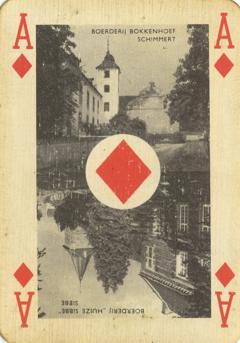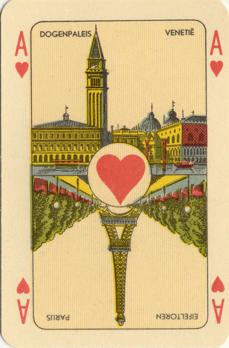  |
|
There have been editions of advertising decks that have scenic aces. Most of them show the company’s buildings, offices, activities or products. Here below are some examples, which come close to the scenic aces in the sense of this article. The first two aces come from a deck that was published in the 1930's for the Bijenkorf, a chain of department stores, the first shows the store in Amsterdam and the second in The Hague. The last two aces come from a deck that was published by the VARA, a Dutch broadcasting organization, and they show the City Hall of Hilversum and the studio of the VARA, also in Hilversum. Both decks came with the SN version of the Rhineland (Dondorf) pattern.
  |
|
In
1946 the "rebuilding" of Holland starts. There is an enormous demand
for general goods and also for playing cards. The competitors from Germany and
Belgium are not yet back in production, so there are more markets to provide
for. The absolute top year for SN is 1948: the turnover increased to Hfl.
371.000, immense figures for those days. As a result the sales activities from
1947 onwards are conducted by a special sales office, located at the
Keizersgracht 633 in Amsterdam. It is lead by Mr. A.A. Haverkate. The company
also invested in a two-colour offset press, which could produce ca. 3500 sheets
p/h. The last lithographic press leaves the production unit: it could only
produce 600 sheets (in one colour!) p/h.
Around 1949 the foreign competition, especially from Belgium, is back and sales
and turnover drop. Another problem is that the big printing orders, other than
for playing cards, are given a higher priority by the management. As a result of
this in 1950 the sales-office could sell more than the ca 800.000 decks, that the
factory can produce. In 1951 the sales-office was closed. Sales were once again
conducted directly by Faddegon. Until the end of the fifties, production, sales
and turnover are stable. The production of playing cards covers about 20% of the
yearly turnover.
|
This deck was published in 1953 by the O.V.M. an insurance company. It has the second version of the SN international pattern and the set of photographic scenic aces shows views of castles, churches, farms and agricultural institutes in the province of Limburg. None shows a direct relation with the publisher. |
|
    |
|
 |
This SN deck was made for the Dutch market in the early 1950's. By that time the Rhineland pattern was rather old-fashioned. The deck came with a set of aces with views of major international sites and cities. |
    |
|
In
1959 the production of playing cards is delayed as a result of the placing of a
new installation for the improvement of the backside of the playing cards. This
was probably part of the general modernization of the SN product, which also
produced a new Anglo-American patterned deck, with two new company jokers, as
the new deck for the national and international market and a Belgian-Genoese
patterned deck (classified as SN-S11) for the French and Belgian market.
Neither came with scenic aces. It's a pity that at this point SN has never
thought of producing a Dutch pattern of its own. By this time the Dutch players
had already become accustomed to the Belgian versions and neither of the newly
developed patterns was attractive for Dutch players.
The decline slowly begins. Deliveries for orders from small, but regular,
customers are sometimes not made in time, as large orders for other products
often get priority. At the end of the 1960's the factory, located in 5 different
- but connected - buildings from the 18th and 19th century, badly needs modernisation. Relocating the factory elsewhere is an
option, but first a general reorganisation is decided.
In 1968 Faddegon merges with the offset printing office Augustin & Schoonman
in Zwanenburg. The new name is A & S Faddegon. The last of the old
directors, J.E.J. Zegers-Veeckens, resides as general director. Sales and
administration are moved to Zwanenburg. Production remains in Amsterdam.
Officially the story ends on March 23rd 1970, when the Belgian playing card
manufacturer NV Van Genechten takes over the remaining playing card activities
of A & S Faddegon for 1 million Belgian francs. This gives them the rights
to the name of the "Speelkaartenfabriek Nederland", access to the
present customer files, the trading relations etc. They were neither interested
in the machinery, nor in the old lithographic stones. Some of these stones with
playing cards on them were found by archaeologists in 1981, when they dug a
ditch at the site on the Haarlemmer Houttuinen, where the factory of Faddegon
had once been.